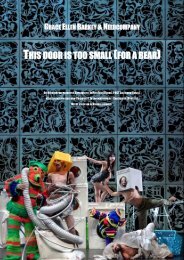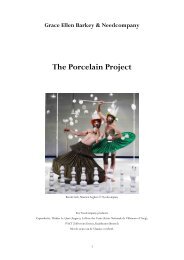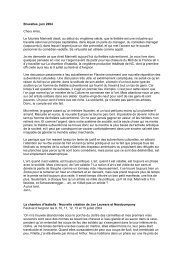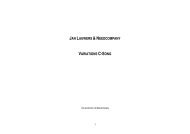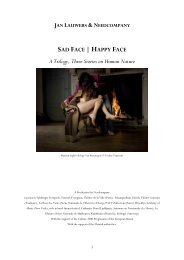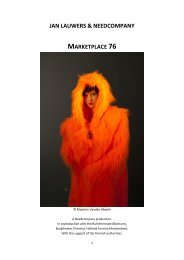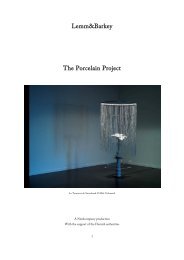THE ART OF ENTERTAINMENT - Needcompany
THE ART OF ENTERTAINMENT - Needcompany
THE ART OF ENTERTAINMENT - Needcompany
Create successful ePaper yourself
Turn your PDF publications into a flip-book with our unique Google optimized e-Paper software.
Lauwers took part of his inspiration for the exhibition from this popular instrument. He produced a large<br />
sculpture, Last Guitar Monster that he described as “a guitar with feedback that plays all by itself and refers<br />
to the masturbation guitar of Jimi Hendrix and The Great Masturbator by Salvador Dalí, the anagram of<br />
which, Avida Dollars, is also a dramatic nod to the tragedy of applause that was rapidly converted into hard<br />
cash in the vulgar capitalist system that we have opted for since the fall of the Berlin wall.” Pop music has<br />
become the victim of the tragedy of applause. In his sculpture, Lauwers looks for the common ground with<br />
the visual arts. The visual artist as a pop musician? Or the pop musician as a critical mirror for the visual<br />
artist? “It is widely known that a lot of pop musicians since Andy Warhol and The Velvet Underground have<br />
come from the field of the visual arts. Which is odd as what pop music doesn’t do is precisely what an artist<br />
should do, namely looking at material and redefining art itself. Pop music is first taken into the grip of the<br />
entertainment industry and is only seen as ‘real’ art sporadically. As art represents the unravelling of the<br />
relationship between the entertainment industry and the merciless art market, we end up realising that<br />
that which is reduced to a format is no longer an image,” according to Lauwers. Image versus format, ‘real’<br />
art versus the entertainment industry, studying material versus applause. The theatre of Jan Lauwers<br />
develops in the open space created by these questions. It uses theatre to reveal the ambiguity of the<br />
medium. Theatre has missed the train of modern art in more ways than one, and in the words of Lauwers,<br />
is “a historical-museum fact”. Theatre has not confronted itself sufficiently. It needs to thoroughly review<br />
its role. I distinguish fundamentally here between directors and creators of theatre. Directors stage a<br />
repertoire and I think that is very important. But for me a performance is only interesting when it is about<br />
the subject of theatre itself. One example is the sculptures of Michelangelo. His works were commissioned<br />
by religious clients, but actually what was important was the material he worked with, the marble. That is<br />
what made him the great artist he is. The tragedy of applause has also played a dangerous role in theatre.<br />
Because the actors and the director want to hear the same applause every evening, they end up in a system<br />
of perfect reproduction. But theatre can escape the hold of the market, you can’t buy a performance like<br />
you can a work of art, you can’t speculate with it on the art market. That’s why theatre is a refuge for<br />
reflection. It is a slow medium and we need to take it a lot more seriously. I have become a great defender<br />
of theatre, which was not at all the case ten years ago. Perhaps we can rediscover the role of art through<br />
theatre?”<br />
2. Voyeurs without illusions<br />
But how far can you take the critical potential of theatre at a time when society has become a ‘show’ in its<br />
deepest innermost fibre. “For something to have meaning, there has to be a scene, and there can only be a<br />
scene if there is illusion, a minimum of illusion, an imaginary movement, a challenge to reality that transports<br />
you, that seduces you, that revolts you. Without this aesthetic, mythical, playful dimension par excellence,<br />
there is not even a political scene where something can take place. And this minimal illusion has disappeared<br />
for us. What we have is an over-representation by the media, but not really a performance. As far as we are<br />
concerned that’s simply obscene because it is made by the media so that it can be watched without being<br />
seen, to be hallucinatingly transparent, absorbed like sex absorbs the voyeur: from a distance. We are not<br />
spectators, nor actors, but voyeurs without illusions.” Instead of the scene, according to the French sociologist<br />
Jean Baudrillard, we have entered the era of ob-scenity. “Illusion is manifested through the scene; reality<br />
manifests itself through the ob-scene.” The difference between reality and fiction is on a dangerously slippery<br />
slope. Because of televised ‘formats’, reality and authenticity are being produced on an assembly line: Big<br />
Brother, The Bachelor, Temptation Island, Fear Factor,... are explicit productions about the strong emotions<br />
that we are no able to experience in our daily lives. In politics and in public spaces, the (auto)production and<br />
6




